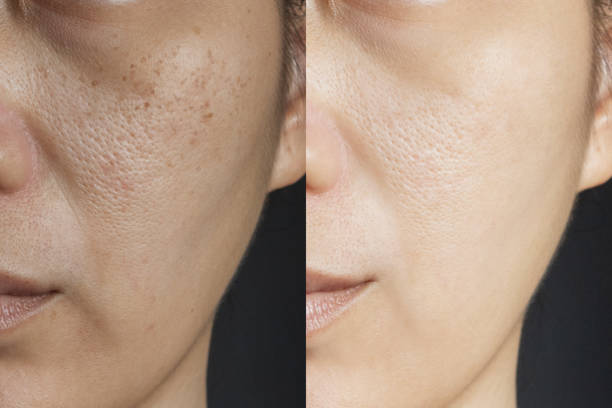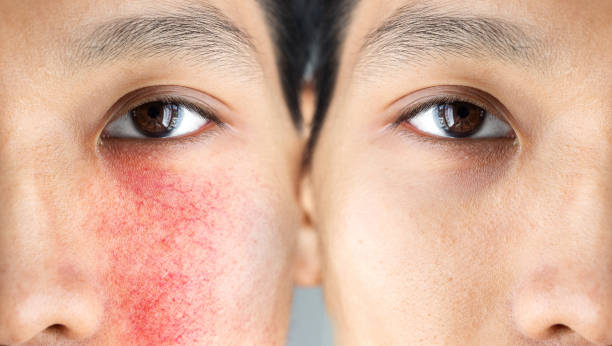Chemical peels can be helpful for managing hormonal acne, but their effectiveness depends on the type and severity of the acne, as well as the specific peel used. Here’s how chemical peels might help:
1. Exfoliation
- Chemical peels exfoliate the skin by removing the top layers of dead skin cells, which can help prevent clogged pores—a common issue in acne-prone skin. This can reduce the frequency of breakouts.
2. Regulation of Oil Production
- Some peels, like salicylic acid peels, can penetrate deeply into the pores and help to reduce excess oil production. This can be particularly beneficial for those with oily skin, which is often associated with hormonal acne.
3. Reduction of Inflammation
- Peels containing ingredients like salicylic acid or glycolic acid have anti-inflammatory properties that can help to reduce the redness and swelling associated with acne lesions.
4. Promotion of Skin Renewal
- Regular chemical peels can promote faster skin cell turnover, which can help fade post-acne marks and improve the overall texture and tone of the skin.
5. Combination with Other Treatments
- Chemical peels are often used in combination with other treatments like topical retinoids or oral medications, which can enhance their effectiveness in managing hormonal acne.
Considerations:
- Skin Sensitivity: People with sensitive skin may experience irritation or increased redness after a peel, so it’s important to choose the right type and strength of peel and to consult with a dermatologist.
- Temporary Worsening: Initially, some people may experience a “purging” phase, where acne temporarily worsens before improving as the skin adjusts to the treatment.
If you’re considering chemical peels for hormonal acne, it’s a good idea to consult with a dermatologist who can recommend the most appropriate treatment based on your specific skin type and condition.

What acid is used in face peel?
Several types of acids are commonly used in facial peels, each with different properties and benefits depending on your skin type and concerns. Here are the most commonly used acids in face peels:
1. Glycolic Acid
- Type: Alpha Hydroxy Acid (AHA)
- Source: Derived from sugar cane
- Benefits: Glycolic acid is known for its ability to exfoliate the outermost layer of the skin, promoting cell turnover and improving the appearance of fine lines, uneven skin tone, and mild hyperpigmentation.
2. Salicylic Acid
- Type: Beta Hydroxy Acid (BHA)
- Source: Derived from willow bark
- Benefits: Salicylic acid is oil-soluble, allowing it to penetrate deep into the pores to exfoliate from within. It’s particularly effective for treating acne, blackheads, and oily skin due to its anti-inflammatory and antibacterial properties.
3. Lactic Acid
- Type: Alpha Hydroxy Acid (AHA)
- Source: Derived from milk or fermented vegetables
- Benefits: Lactic acid is a milder exfoliant compared to glycolic acid and is often used for sensitive skin. It helps to hydrate the skin while exfoliating, improving texture and reducing the appearance of fine lines and dark spots.
4. Mandelic Acid
- Type: Alpha Hydroxy Acid (AHA)
- Source: Derived from bitter almonds
- Benefits: Mandelic acid is another mild AHA, known for its gentle exfoliating properties. It’s particularly suitable for those with sensitive or darker skin tones, as it has a lower risk of causing irritation or hyperpigmentation.
5. TCA (Trichloroacetic Acid)
- Type: Stronger acid peel
- Benefits: TCA peels are medium to deep peels used for more significant exfoliation, addressing issues like deep wrinkles, sun damage, and scars. Due to its potency, it is usually administered by professionals.
6. Jessner’s Solution
- Type: Combination peel (typically contains lactic acid, salicylic acid, and resorcinol)
- Benefits: This peel is designed to treat hyperpigmentation, acne, and aging skin. It’s a medium-depth peel that can address multiple skin concerns at once.
7. Phenol
- Type: Deep peel
- Benefits: Phenol is used in deep chemical peels and is highly effective for treating deep wrinkles, severe sun damage, and significant hyperpigmentation. This type of peel requires a longer recovery time and is usually done under medical supervision.
Each of these acids offers different benefits, and the choice of acid will depend on your skin type, concerns, and the desired depth of peel. It’s always recommended to consult with a dermatologist or skincare professional to determine the best option for your specific needs.
